|
|
|
|
|
|
Völuspá 8
|
Tefldu í túni, teitir váru,
var þeim vettergis vant ór gulli,
uns þrjár kvámu þursa meyjar
ámáttkar mjök ór Jötunheimum.
|
Happily they (the gods) played Tafl in the court,
they lacked nothing made of gold;
until three thurs maidens came,
dangerously strong, out of Jotunheim.
|
| |
|
The three giantesses who spoil the Golden
Age are often
identified as the three Norns, but Urd and her sisters would
never be referred to as ámáttkar þursar, a
designation reserved for the most dangerous foes of the gods. There is,
however, another possibility also
named in Völuspá, a central figure in the poem known as
Gullveig-Heid in stanzas 21-22, and, in exile, the
"Old One in the Ironwood" in stanzas
40-41. These powerful female figures have never been adequately explained. As
Gullveig, she is a jotun at the center of a dispute between the
Aesir and Vanir, but Snorri doesn't mention her in either his
Edda or Heimskringla's Ynglingasaga. The Fornaldarsaga, Völsungasaga preserves a record concerning a
giantess, skilled in witchcraft, who was admitted to Asgard as a
maid-servant of Frigg. The poem Fjölsvinnsmál st.
38, has the giantess Aurboda as a goddess at Menglad-Freyja's
feet. In Saxo's Danish History, Book VII, the hero Otharus (Odr)
rescues the princess Syritha (Sýr, a name of Freyja), held by
giants. In the story, a maidservant, which some say was a giant in
disguise, betrayed the girl to the monsters. Otharus frees her from
Jotunheim, allowing Voluspa 25 to ask "Who gave Odr's girl to
the jotuns?" A comparison of these sources
reveals the nature of this giantess among the Asynjur.
Völsungasaga (ch. 2) relates that the giant Hrímnir's daughter
first dwelt in Asgard as the maid-servant of Frigg, and then on
earth. When a king and queen, who had long been without
children, beseeched the gods for an heir, Frigg heard their
prayers and sent to them the daughter of the giant Hrímnir, a
giantess named Hljod who had been adopted in Asgard as Odin's
"wish-maid." Assuming the shape of a crow, Hrimnir's daughter
took an apple with her, and once delivered, it was
not long before the Queen's wish would come to pass; but
she would die in childbirth of a son named Volsung. Apparently
the apple was poisoned.
Hyndluljóð states that Hrímnir's daughter is named Heið, and
mentions no sister of hers, but, on the other hand, a brother
Hrossþjófr "Horse-thief" (Heiðr og Hrossþjófr Hrímnis kindar -
Hyndl. 30). According to Volsungasaga, during her sojourn
on earth, Hrimnir's daughter became the wife of a king, and with
him became the mother and grandmother of were-wolves, who
infested the woods and murdered men. The circumstance that the
giantess in Volusngasaga first dwelt in Asgard and thereupon in
Midgard, indicates that she is a parallel figure to
Gullveig-Heid in Völuspá (see below), and thier identity is
confirmed by the statement that she is a daughter of the giant
Hrímnir.
Similarly, we discover a giant handmaiden among the circle
around Menglad-Freyja. Of this we are assured by the poem
Fjölsvinnsmál, where, it is related that when Svipdag came to
the gates of Asgard, he sees Menglad-Freyja, who was destined to
be his wife, sitting on a hill surrounded by maidens whose very
names, Eir, Björt, Blíðr, and Fríð, tell us that they are
goddesses. Eir is the Asynja of the healing art (Prose Edda, i.
114). Björt, Blid, and Frid are the dises of splendor,
benevolence, and beauty. They are mighty beings, and can give
aid in distress to all who worship them (Fjölsvinnsmál 40). But
in the midst of this circle of dises, Svipdag also sees Aurboða
(Fjölsvinnsmál 38).
Of the one as of the other, it is related that she was a volva
of the giant-race, who nevertheless dwelt for some time in
Asgard, and was employed by Frigg or Freyja in the service of
fertility. |
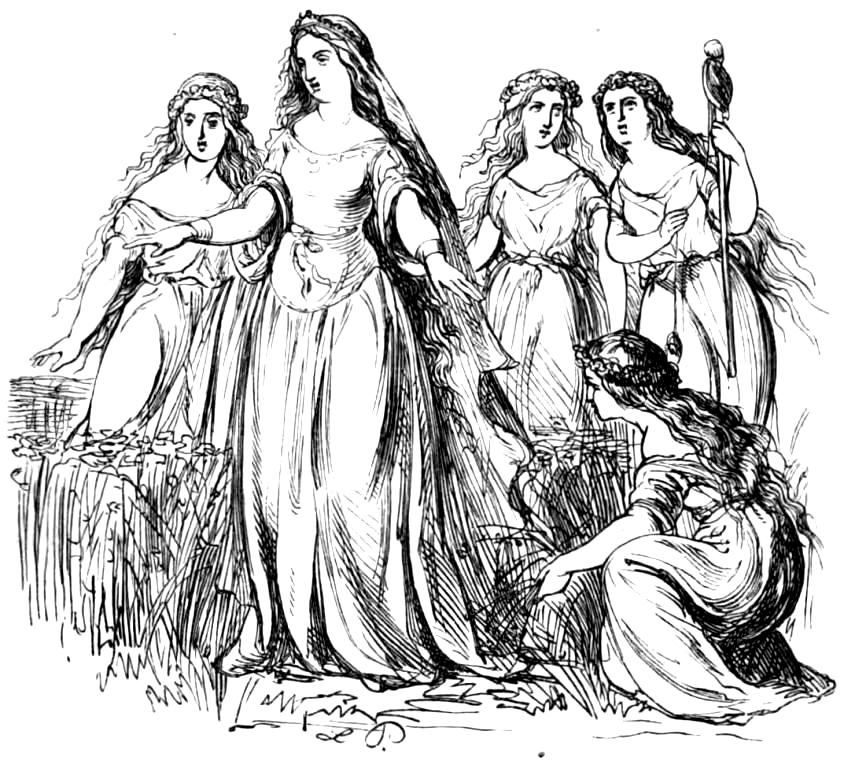
Menglad and her Maidens
Among whom is Aurboda, Fjösvinsmál 38
1865 Ludwig Pietsch
|
Hyndluljóð informs us
that Menglad-Freyja's servant Aurboda, is the mother of her
brother's wife.
|
Freyr átti Gerði,
hon var Gymis dóttir,
jötna ættar, ok Aurboðu;
|
Freyr
married Gerd,
she was the daughter of Gymir
and Aurboda, the kin of jötuns. |
The Tale of Otharus (Odr) and Syritha (Syr = Freyja) in Book
7 of Saxo's Danish History suggests that Freyja was once
betrayed to the giants by just such a maid servant:
"Then one Ottar, the son of Ebb, kindled with
confidence in the greatness either of his own
achievements, or of his courtesy and eloquent address,
stubbornly and ardently desired to woo the maiden
(Syritha, Freyja). And though he strove with all the
force of his wit to soften her gaze, no device whatever
could move her downcast eyes; and, marvelling at her
persistence in her indomitable rigour, he departed.
"A giant desired the same thing, but, finding himself
equally foiled, he suborned a woman; and she, pretending
friendship for the girl, served her for a while as her
handmaid, and at last enticed her far from her father's
house, by cunningly going out of the way; then the giant
rushed upon her and bore her off into the closest
fastnesses of a ledge on the mountain. Others think that
he disguised himself as a woman, treacherously continued
his devices so as to draw the girl away from her own
house, and in the end carried her off.
"When Ottar heard of this, he ransacked the recesses of
the mountain in search of the maiden, found her, slew
the giant, and bore her off."
|
GULLVEIG-HEID
Thrice Burnt, Thrice Reborn |
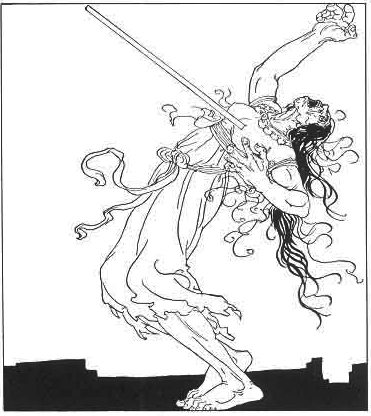
The Death of Gullveig
1920 Willie Pogany |
|
|
Völuspá 21-22:
| |
Þat man hon
folkvíg fyrst í heimi,
er Gullveigu
geirum studdu
ok í höll Hárs
hana brenndu -
þrysvar brenndu
þrysvar borna,
opt, ósjaldan -
þó hon enn lifir.
|
She remembers
the world’s first war,
when Gullveig
was pierced with spears
in the High One’s hall
she was burnt.
Thrice burnt,
thrice born,
often, not seldom,
yet she still lives.
|
| |
Heiði hana hétu
hvars til húsa kom,
völu vel spá,
vitti hon ganda.
Seið hon kunni,
seið hon leikin,
æ var hon angan
illrar þjóðar. |
Heid they called
her
Wherever she visited,
a far-sighted seeress,
she conjured with wands,
in magic she was versed,
in magic she was deft,
always cherished
by evil people.
|
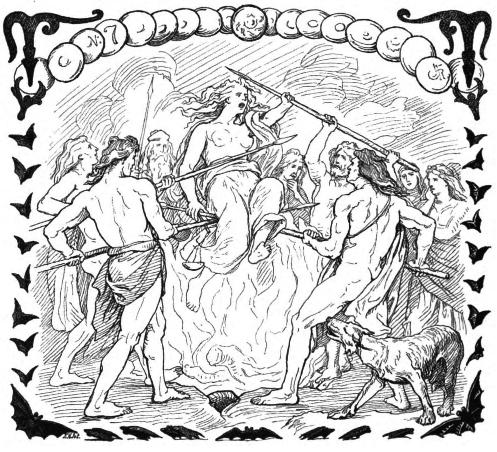
Völuspá 21-22: The Aesir Burn Gullveig
1885 Lorenz Frølich
(and below)
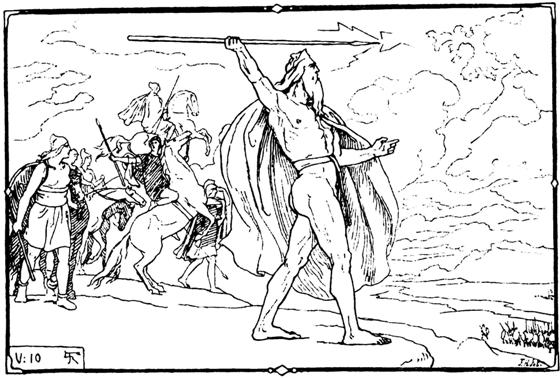
Völuspá 24: Odin Declares War on
the Vanir
Gullveig's acts in
antiquity as the founder of the diabolical magic
art, as one who awakens man's evil passions and
produces strife in Asgard causing conflict
between the Aesir and Vanir. Ynglingasaga (ch.
4) relates a tradition that Freyja kendi
fyrst med Ásum seið, that Freyja was the
first to practice sorcery in Asgard. There is no
doubt that the statement is correct. For we have
seen that Gullveig-Heid, the sorceress and
spreader of sorcery in antiquity, succeeded in
getting admission to Asgard, and that Aurboda is
particularly mentioned as belonging to the
circle of serving dises who attend Freyja. As
this giantess was so zealous in spreading her
evil arts among the inhabitants of Midgard, it
would be strange if the myth did not make her,
after she had gained Freyja's confidence, try to
betray her into practicing the same arts.
Doubtless Völuspá and Saxo have reference to
Gullveig-Heid-Aurboda when they say that Freyja,
through some treacherous person among her
attendants, was delivered into the hands of the
giants. In his historical account relating how
Freyja (Syritha) was robbed from Asgard and came
to the giants but was afterwards saved from
their power, Saxo says that a woman, who was
secretly allied with a giant, had succeeded in
ingratiating herself in her favor, and for some
time performed the duties of a maid-servant at
her home; but this she did in order to cunningly
entice her away from her safe home to a place
where the giant lay in ambush and carried her
away to the recesses of his mountain country.
Thus Saxo informs us that it was a woman among
Freyja's attendants who betrayed her, and that
this woman was allied with the giant world,
which is hostile to the gods, while she held a
trusted servant's place with the goddess.
Aurboda is the only woman connected with the
giants in regard to whom our mythic records
inform us that she occupied such a position with
Freyja; and as Aurboda's character and part,
played in the epic of the myth, correspond with
such an act of treason, there is no reason for
assuming the mere possibility that the betrayer
of Freyja may have been some one else who is
neither mentioned nor known. With this, it is
important to compare Völuspá 25-26, which not
only mention the fact that Freyja came into the
power of the giants through treachery, but also
informs us how the treason was punished.
Why have the Vanir objected to the killing of
Gullveig-Heid? Should this clan of gods,
celebrated in song as benevolent, useful, and
pure, be kindly disposed toward the evil and
corrupting arts of witchcraft? This cannot have
been the meaning of the myth. The explanation of
the fact is that Frey, on account of a passion
of which he is the victim (probably through
Aurboda's sorcery), was driven to marry the
giant maid Gerd, whose kin in that way became
friends of the Vanir. Frey is obliged to demand
satisfaction for a murder perpetrated on a
kinswoman of his wife. The kinship of blood
demands its sacred right, and according to
Germanic ideas of law, the Vanir must act as
they do regardless of the moral character of his
mother-in-law.
Aurboda is Frey's mother-in-law,
consequently his close relation; and it must
have been on behalf of a near relation that Frey
and Njörd demanded satisfaction from the Aesir
when the Aesir slew Gullveig-Heid. We must
consider that nearly all mythic characters are
polyonomous, and that the Germanic mythology
particularly, is burdened with a
highly-developed polyonomy. Under such
circumstances, it is difficult to regard them as
otherwise than identical. Thus, when the
gods capture and burn Gullveig for spreading
witchcraft among mankind and giving Freyja to
the giants, the Vanir object and demand
weregild. |
THE MOTHER OF THREE
MONSTERS
LOKI'S OTHER HALF
The Poetic Edda, Hyndluljóð 38:
| |
Ól ulf Loki
við Angrboðu,
en Sleipni gat
við Svaðilfara;
eitt þótti skass
allra feiknast,
þat var bróður
frá Býleists komit.
Loki át hjarta
lindi brenndu,
fann hann halfsviðinn
hugstein konu;
|
Loki begat the wolf
with Angrboda,
but Sleipnir he begat
with Svadilfari:
one monster seemed
of all most deadly,
which from Byleist's
brother sprang.
Loki ate the heart
a little burnt,
he found half-scorched
the woman's life-stone.
|
| |
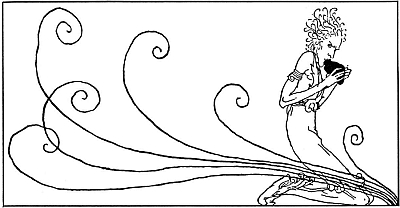
Loki ate the Witch's Heart
1920 Willie Pogany |
From the account, we see that an evil female being (ill
kona) had been burnt, but that the flames were not able to
destroy the seed of life in her nature. Her heart had not
been burnt through or changed to ashes. It was only
half-burnt (hálfsviðinn hugsteinn), and in this condition it
had been thrown away together with the other remains of the
cremated woman, for Loki finds and swallows the heart.
The half-burnt heart contained the evil woman's soul, and
its influence upon Loki, after he swallowed it, was most
remarkable. Once before he bore Sleipnir with the giant
horse Svaðilfari, the witch's heart redeveloped the feminine
in him (Loki lindi af brendu hjarta). It fertilized him with
the evil purposes which the heart contained. Loki became the
"father" of the children from which all trolls (flagð) came
into the world. First among the children is mentioned the
wolf, which is named Fenrir, and which shall cause the death
of the All-Father in Ragnarok. Njörd's words about Loki, in
Lokasenna 33 point to this event: áss ragr er hefir börn
of borið.
The woman possessing the half-burnt
heart, who is the mother or rather the father of the wolf,
is called Angurboða (ól úlf Loki við Angurboðu). N. M.
Petersen and other mythologists have rightly seen that she
is the same as "the old one in the Ironwood" and "there
fosters Fenrir's kinsmen" (Völuspá 40), her own offspring,
which at the end of this age are to issue from the Ironwood,
and break into Midgard and dye its citadels with blood
(Völuspá 41).
As Gullveig was burnt and reborn three times, Loki appears
to have found and eaten the half-burnt heart each time,
bearing a monster each time.
Snorri's Edda, Gylfaginning 34: Yet more children had
Loki. Angrboda was the name of a certain giantess in Jötunheim,
with whom Loki begat three children: one was Fenris-Wolf, the
second Jörmungandr--that is the Midgard Serpent,--the third is
Hel. But when the gods learned that this kindred was fed
in Jötunheim, and when the gods perceived by prophecy that from
this kindred great misfortune should befall them; and since it
seemed to all that there was great prospect of ill —(first from
the mother's blood, and yet worse from the father's)— then
Allfather sent gods thither to take the children and bring them
to him. When they came to him, straightway he cast the serpent
into the deep sea, where he lies about all the land; and this
serpent grew so greatly that he lies in the midst of the ocean
encompassing all the land, and bites upon his own tail. Hel he
cast into Niflheim, and gave to her power over nine worlds, to
apportion all abodes among those that were sent to her: that is,
men dead of sickness or of old age. ... The Wolf the Æsir
brought up at home, and Týr alone dared go to him to give him
meat."
|
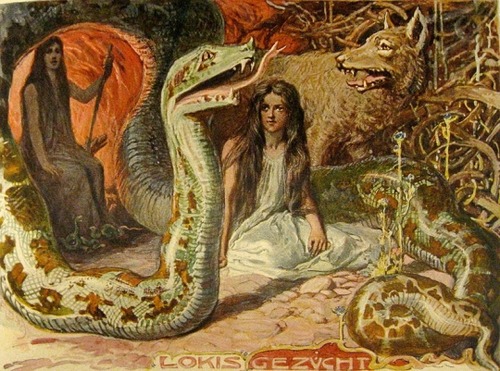
Loki's Offspring
1905 Carl Emil Doepler Jr.
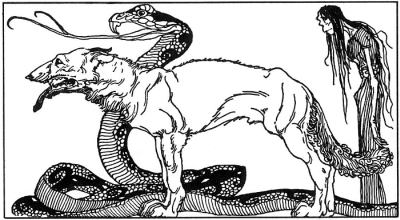
Three Monsters
1920 Willie Pogany
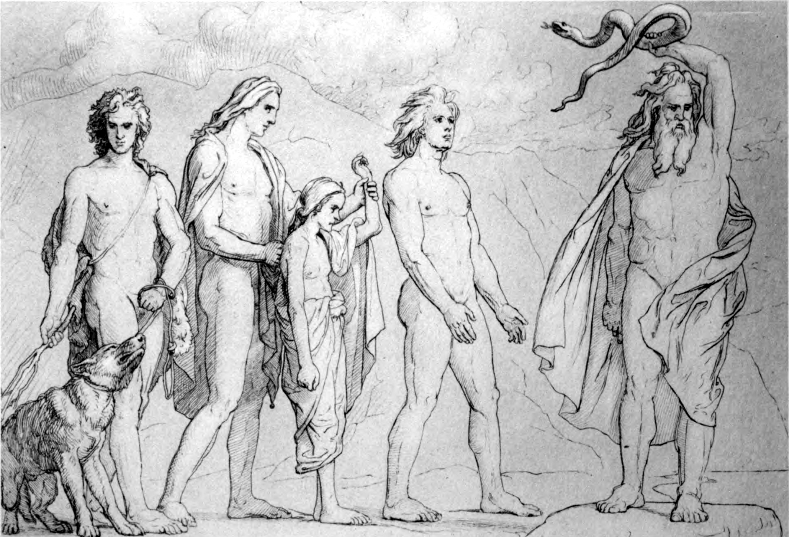
Loki's Children
1885 Lorenz Frølich

Loki and Angrboda
1885 Lorenz Frølich |
The Poetic Edda, Vegtamskviða:
Odin:
|
"Ert-at-tu völva
né vís kona,
heldr ertu
þriggja þursa móðir."
|
19. "Thou art no Volva,
nor wise woman,
rather art thou
the mother of three Thursar!" |
Volva:
|
|
|
"Heim ríð þú, Óðinn,
ok ver hróðigr,
svá komir manna
meir aftr á vit,
er lauss Loki líðr
ór böndum
ok ragna rök
rjúfendr koma."
|
"Ride home Odin!
and be exulted,
never more shall man
again visit me,
until Loki is loose
from his bonds
and Ragnarök
all-destroying comes." |
|
THE OLD ONE IN THE IRON WOOD
Breeding Fenrir's Kin There
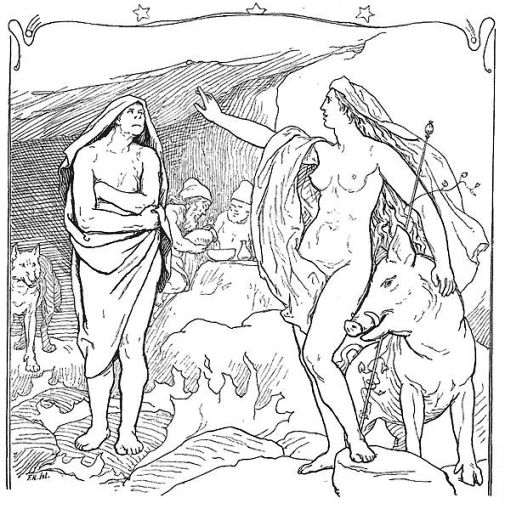
Hyndla and Freyja
1894 Lorenz Frølich
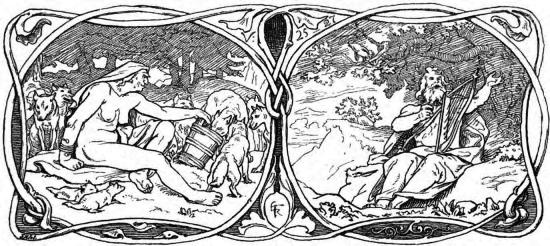
Scenes from Völuspá:
The Old One in the Ironwood
breeding Fenrir's kin and Her Herder |
Völuspá 40-41:
|
|
Austr
sat in aldna í Járnviði
ok fæddi þar Fenris kindir;
verðr af þeim öllum einna nokkurr
tungls tjúgari í trölls hami.
Fyllisk fjörvi feigra manna,
rýðr ragna sjöt rauðum dreyra;
svört verða sólskin um sumur eftir,
veðr öll válynd. Vituð ér enn - eða hvat? |
East in
the Ironwood sat the Old One
and breeding Fenrir's kin there;
of them all one shall become the
moon's pitchfork in troll guise.
He gorges on lives of death-doomed men,
Reddens the skies with gore; The summer sun darkens,
wild storms arise-
Do you seek to know yet more? |
Gylfaginning 12:
"A witch dwells to the east of Midgard, in the forest called
Ironwood: in that wood dwell the troll-women, who are known as
Ironwood-Women. The old witch bears many giants for sons, and
all in the shape of wolves; and from this source are these
wolves sprung. The saying runs thus: from this race shall come
one that shall be mightiest of all, he that is named Moon-Hound;
he shall be filled with the flesh of all those men that die, and
he shall swallow the moon, and sprinkle with blood the heavens
and all the lair; thereof-shall the sun lose her shining, and
the winds in that day shall be unquiet and roar on every side. "
In the Ironwood, the giantess Angrboða (cp. Aurboða) dwells
together with a giant, who is gýgjar hirðir, the
giantess' guardian and watcher. He has charge of her
monsterous herds, and also guards a sword brought to the
Ironwood. This vocation has given him the epithet Eggþér, which
means sword-guardian. Saxo speaks of him as Egtherus, an ally of
Finns, skilled in magic, and a chief of Bjarmians, equally
skilful in magic (Book 5). In Völuspá's description of the
approach of Ragnarok, Egther, Angrboda's shepherd, is
represented as sitting on a mound - like Aurboda's shepherd in
Skírnismál - and playing a harp, happy over that which is to
happen. That the giant who is hostile to the gods, and who is
the guardian of the strange herds, does not play an idyl on the
strings of his harp does not need to be stated.
|
THE GIANTESS HYRROKIN
"THE FIRE-SMOKED"
Snorri's Edda, Gylfaginning 49: "The Æsir took the body
of Baldr and brought it to the sea. Hringhorni is the name of
Baldr's ship: it was greatest of all ships; the gods wanted to
launch it and make Baldr's pyre thereon, but the ship would not
stir. Then word was sent to Jötunheim and in response, came a
giantess named Hyrrokkin (Fire-smoked). She rode up on a wolf
with a serpent for a bridle, and leapt off the steed. Odin
called four berserks to subdue it; but they were not able to
tame the steed until they had felled it. Hyrrokkin went to
the prow of the ship and thrust it out on the first push, with
such force that fire burst from the rollers and all lands
trembled. Thor grew angry and clutched his hammer, and
straightaway would have broken her head, had the gods not prayed
for peace for her."
A strophe by Thorbjorn Disarskald, preserved in the
Prose Edda, states that Hyrrokin was one of the
giantesses slain by Thor. But the very appellation
Hyrrokin, which must be an epithet of a giantess known
by some other more common name, indicates that some
effort worthy of being remembered in the myth had been
made to burn her, but that the effort resulted in her
being smoked rather than burnt; for the epithet Hyrrokin
means the "fire-smoked." For those familiar with the
contents of the myth, this epithet was regarded as plain
enough to indicate who was meant. If it is not,
therefore, to be looked upon as a misleading epithet, it
must refer to Gullveig, thrice burnt in vain. All that
we learn about Hyrrokin confirms her identity with
Aurboda. In the symbolic-allegorical work of art, which
decorated a hall at Hjardarholt toward the close of the
tenth century, the storm which from the land side
carried Baldur's ship out on the sea is represented by
the giantess Hyrrokin. Gymir's wife, Aurboða, appears in
the same capacity of storm-giantess carrying sailors out
upon the ocean, in a poem by Refr (Skáldskaparmál 25,
61):
|
Færir björn, þar er bára
brestr, undinna festa,
opt í Ægis kjapta
úrsvöl Gymis völva
|
"Gymir's primeval-cold
volva
often carries the ship into Ægir's jaws." |
In the physical interpretation of the myth, Aurboda's
husband Gymir represents the east wind coming from the
Ironwood. From the other side of the Baltic, Gymir sings
his song (Ynglingatal 25); and the same gale belongs to
Aurboda, for Aegir, into whose jaws she drives the
ships, is the great open western ocean. That Aurboda
represents the gale from the east finds its natural
explanation in her identity with Angurboda "the old,"
who dwells in the Ironwood in the uttermost east,
Austr býr in aldna í Járnviði (Völuspá 40). |
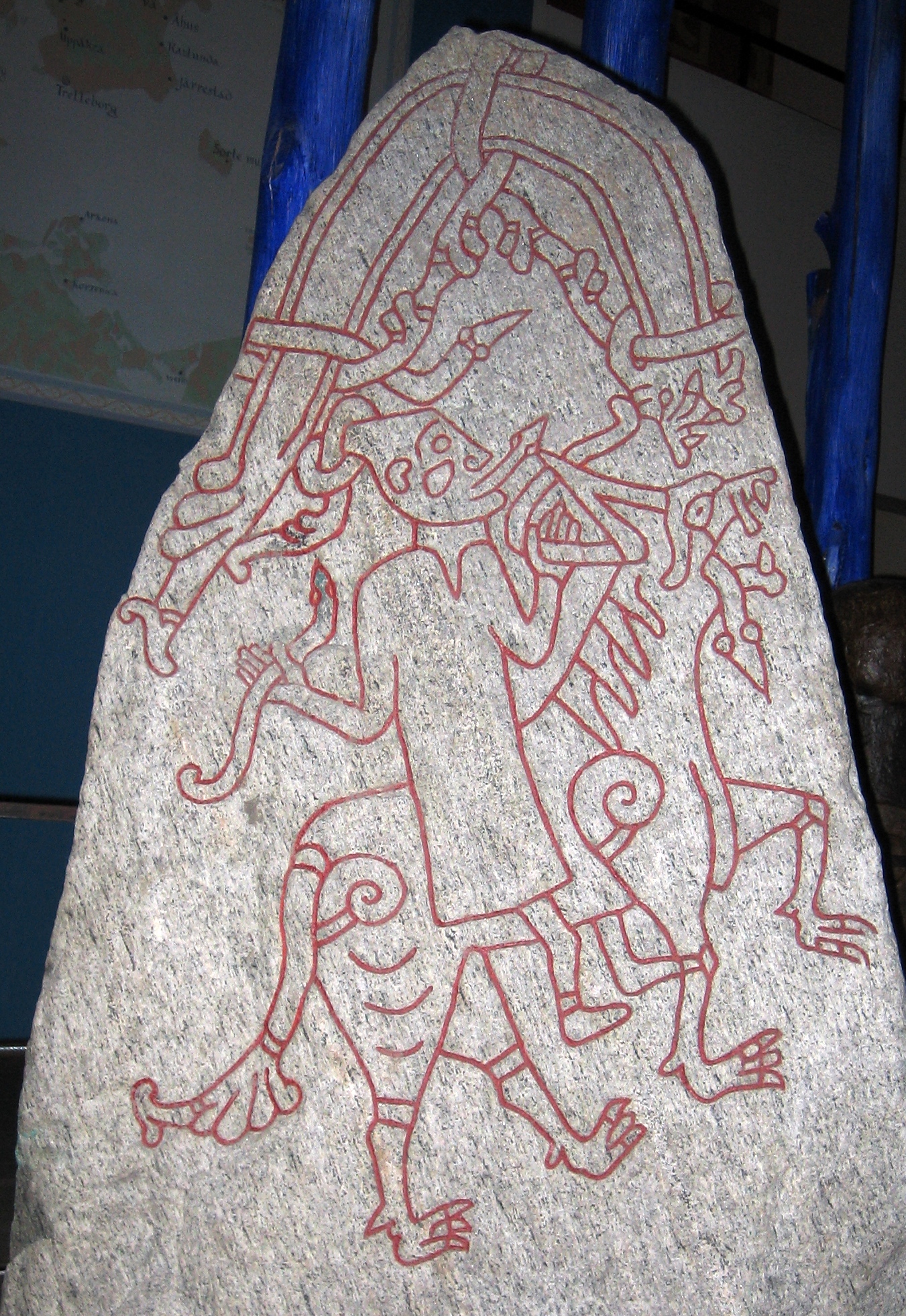
Runestone dr 284
The Hunnestad Monument 3
Lund, Sweden

The Giantess Hyrrokin
1837 William Kaulbach
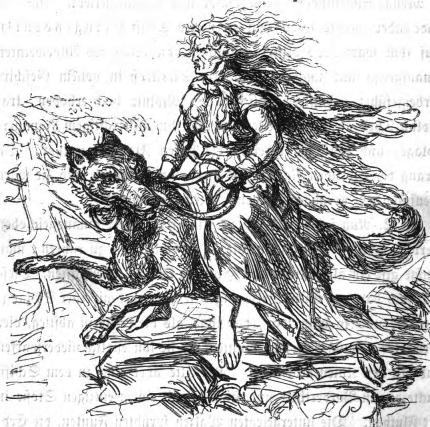
The Giantess Hyrrokin
1865 Ludwig Pietsch

The Giantess Hyrrokin
1882 Kate Greenaway
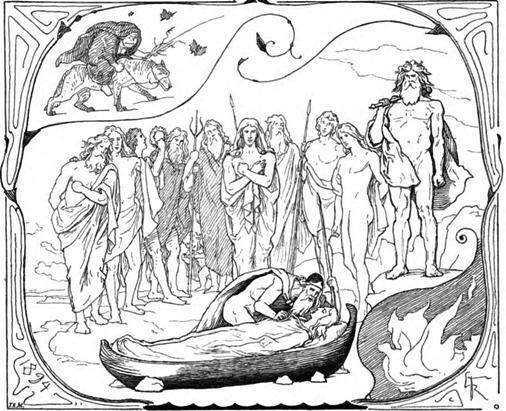
Hyrokinn Arrives at Baldur's Funeral
1894 Lorenz Frølich
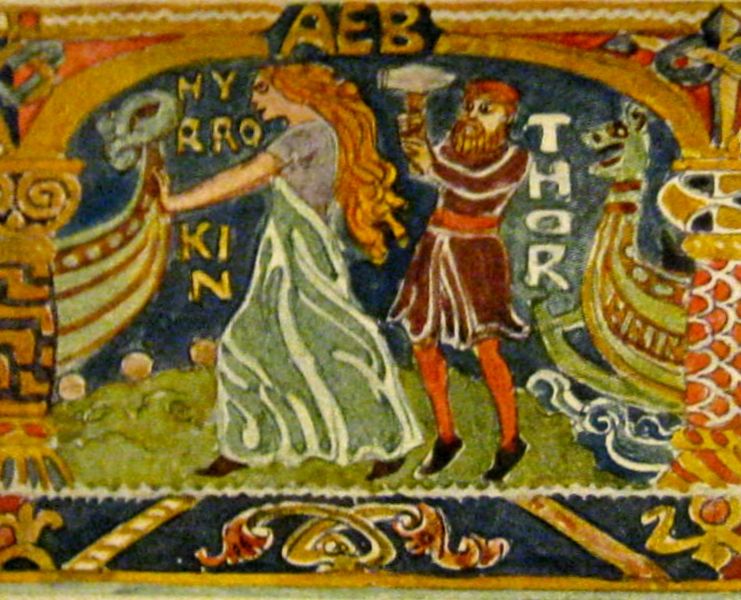
Hyrrokin Launches Baldur's Pyre
1905 Carl Emil Doepler Jr.
|
| |
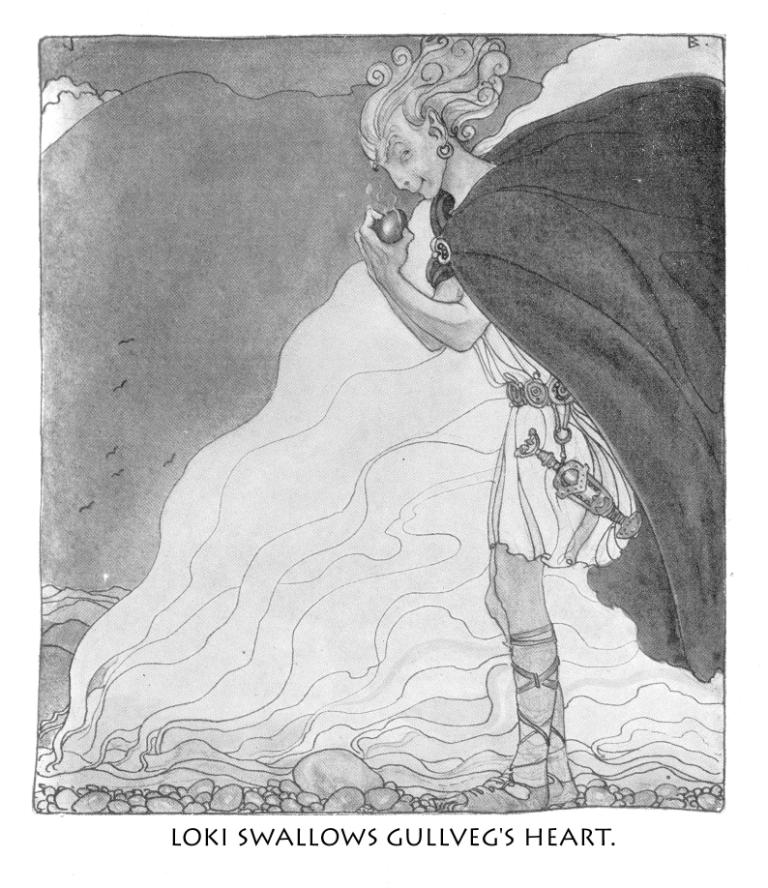
1911 John Bauer
|

The Giantess Hyrrokin Launches Baldur's Pyre
1930 Katherine Pyle |
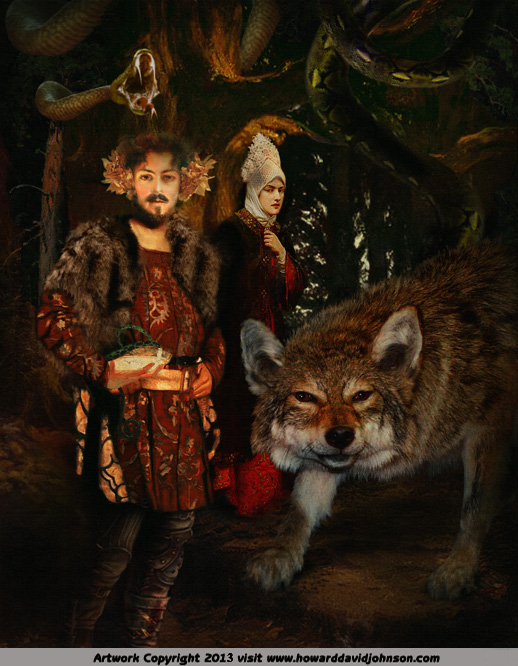
Loki and His Children
2013 Howard David Johnson
HowardDavidJohnson.com
|
[HOME][POPULAR RETELLINGS][THEMES
IN OLD NORSE ART] |
|

















